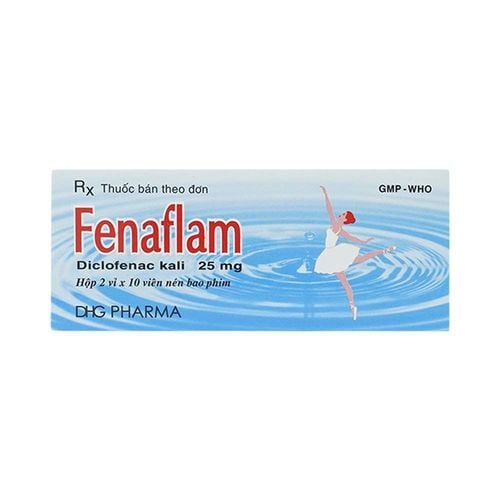This is an automatically translated article.
Amvifeta is paracetamol, which has analgesic and antipyretic effects. Amvifeta in the form of an infusion solution is used for short-term relief of pain, usually postoperative pain.
1. Uses of Amvifeta
Amvifeta belongs to the group of pain relievers and antipyretics, non-steroidal anti-inflammatory drugs, with the main ingredient being the active ingredient Paracetamol, content of 1g. Paracetamol's main effect is to help relieve pain and reduce fever, can be used as an alternative to aspirin, but does not have the anti-inflammatory properties of aspirin.
The advantage of Paracetamol in Amvifeta is that it has little impact on the functioning of the respiratory and cardiovascular systems, as well as does not upset the acid and base balance. In addition, Paracetamol does not cause gastric irritation, gastrointestinal bleeding.
Amvifeta is prepared in the form of an infusion solution and is indicated in the treatment of moderate pain of short duration, postoperative pain and fever reduction.
2. How to use and dose Amvifeta
Amvifeta is given by intravenous infusion and is to be administered by a healthcare professional or a doctor. The duration of the intravenous infusion is approximately 15 minutes and the interval between each infusion is a minimum of 4 hours.
Dosage of Amvifeta in adults is based on specific weight as follows:
Weight over 50kg: 1g/time, re-infusion after 4-6 hours but the maximum daily dose should not exceed 4g. Weight less than 50kg: 15 mg/kg body weight/time, re-infusion after 4-6 hours but the maximum daily dose should not exceed 60mg/kg body weight. In people with dehydration, alcoholism, chronic malnutrition, the maximum dose is 3g/day. Dosage of Amvifeta in children is based on specific weight as follows:
Preterm infants over 32 weeks of gestation: Infusion 7.5 mg/kg body weight, every 8 hours and the maximum dose should not exceed 25 mg/kg. kg body weight/day. Full-term infants and weighing less than 10kg: 10mg/kg body weight infusion, re-infusion Amvifeta after 4-6 hours but the maximum daily dose should not exceed 30mg/kg body weight. Children weighing 10 - 50 kg: Infusion 15mg/kg body weight, re-infusion after 4-6 hours, but the maximum daily dose should not exceed 60mg/kg body weight. Children weighing more than 50kg: Use the same dose as adults. Note, for patients with severe renal impairment (creatinine clearance less than 30ml/min), the interval between infusions of Amvifeta should be at least 6 hours.
Overdose of Amvifeta in particular and paracetamol in general can cause severe liver damage and acute tubular necrosis.
3. Amvifeta side effects
Amvifeta drug may cause some unwanted side effects with the frequency of occurrence as follows:
Uncommon: Skin rash, nausea, vomiting, anemia, hematopoietic disorders, nephrotoxicity, disease kidney. Rare: Skin reactions such as Stevens-Johnson syndrome, Lyell's syndrome, toxic epidermal necrolysis, acute generalized exanthematous pustulosis. Although Amvifeta rarely causes these side effects, if they do, they should be stopped immediately to limit the risk of death. Other: Hypersensitivity reactions may occur. If you have any strange symptoms after taking Amvifeta, you should contact your doctor or pharmacist as soon as possible.
4. Some notes when taking Amvifeta
Do not use Amvifeta in people with kidney failure, liver failure and severe anemia; people with hypersensitivity to paracetamol or its components; people with G6PD deficiency. People with drinking habits, chronic alcoholism, dehydration, chronic malnutrition need to be cautious when using Amvifeta. During the course of taking Amvifeta, the patient should not take any other drugs that also contain paracetamol. As soon as possible, oral Amvifeta should be switched to. Amvifeta should be used with caution in patients with anemia because it may increase methemoglobin levels in the blood, but it is not obvious. Do not drink alcohol while taking Amvifeta because it can increase liver toxicity. Pregnant women should only use Amvifeta when absolutely necessary, because research on safety in this group of subjects is limited. Amvifeta can interact with the following drugs: slightly increase the anticoagulant effect of coumarin when taking high doses of paracetamol for a long time (however, this effect is mild, so paracetamol is still preferred); severe fever reduction if the patient is given concomitant antipyretic therapy or phenothiazines; Increased hepatotoxicity when used with anticonvulsants, especially when taking high doses of paracetamol. Therefore, to avoid harm to the liver, patients taking anticonvulsants should limit the use of Amvifeta. Amvifeta is used as an infusion to relieve pain and reduce fever for moderate and short-term pain. To ensure the effectiveness of treatment and avoid unwanted side effects, patients need to strictly follow the instructions of the doctor, professional pharmacist.
Follow Vinmec International General Hospital website to get more health, nutrition and beauty information to protect the health of yourself and your loved ones in your family.
Please dial HOTLINE for more information or register for an appointment HERE. Download MyVinmec app to make appointments faster and to manage your bookings easily.













